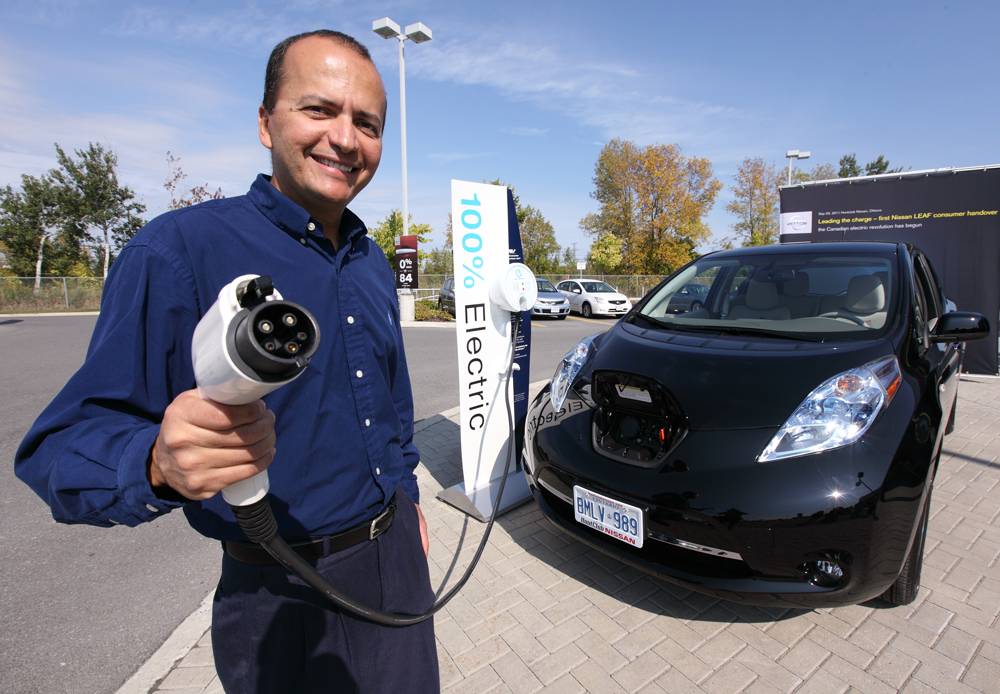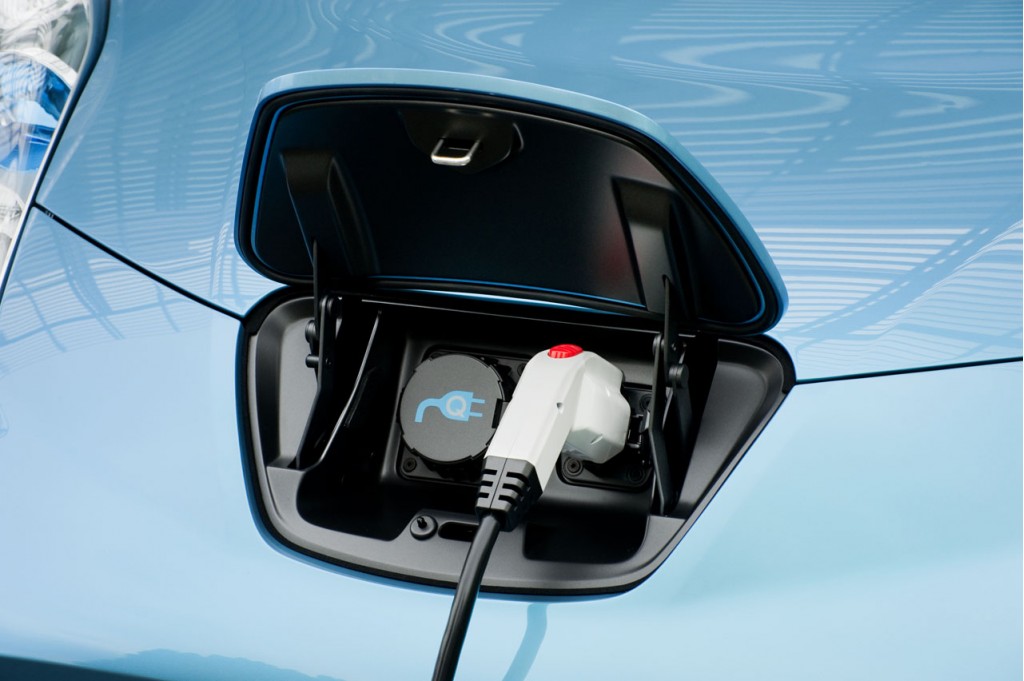![2012 Nissan Leaf in the autumn outside Ottawa, Ontario, Canada [photo: Ricardo Borba] 2012 Nissan Leaf in the autumn outside Ottawa, Ontario, Canada [photo: Ricardo Borba]](https://images.hgmsites.net/lrg/2012-nissan-leaf-in-the-autumn-outside-ottawa-ontario-canada-photo-ricardo-borba_100445702_l.jpg)
2012 Nissan Leaf in the autumn outside Ottawa, Ontario, Canada [photo: Ricardo Borba]
Modern electric cars went on sale three years ago, and now we're starting to see assessments of their progress from a variety of perspectives.
Last year, WWF Canada (the panda people, not the professional wrestlers) set a goal of having 600,000 electric vehicles on Canadian roads by 2020 – or about 3 percent of the country's vehicle fleet of 20 million.
One year later, the group has issued a status update, grading the country's progress on these fronts.
WWF proposes that to achieve their 2020 goal, Canada must create conditions where plug-in electric cars enjoy:
- comparative pricing (removing the "plug-in price penalty" for early adopters)
- extensive charging infrastructure (30,000 public and workplace charging stations by 2020)
- broad public awareness (i.e. literacy about plug-in cars among the car-buying public)
- available electric models of different car types and at different price levels ("a plug-in for every purse and purpose", as Alfred Sloan might say)
- increased environmental benefits (further cleaning the grid, to heighten electric vehicles' environmental advantages)
Sun Country Highway electric-car charging station, Burnaby, BC, Canada [photo: Matthew Klippenstein]![Sun Country Highway electric-car charging station, Burnaby, BC, Canada [photo: Matthew Klippenstein] Sun Country Highway electric-car charging station, Burnaby, BC, Canada [photo: Matthew Klippenstein]](https://images.hgmsites.net/lrg/sun-country-highway-electric-car-charging-station-burnaby-bc-canada-photo-matthew-klippenstein_100443109_l.jpg)
Calculating market share
The group pegs plug-in electric vehicles at about 0.32 percent of the Canadian new car market today, or about double the 0.15 percent calculated in our monthly Canadian plug-in electric sales reports.
The difference comes because the WWF excludes light-duty trucks and sport-utility vehicles from its analysis--because electric options aren't yet available in those market segments.
This is also how it calculates plug-ins to have fully a 2.9 percent market share of of new-car sales in California. The WWF simply ignores trucks.
Recommendations & commentary
1. B.C., Ontario, and Quebec should continue to offer their incentive programs.
2. Other provinces should introduce similar incentives for buying EVs.
3. Federal and provincial governments should introduce other programs to reduce the price barrier to EVs.
The first three recommendations deal with incentive programs, to address the "comparative pricing" bullet above.
WWF Canada will certainly applaud Quebec's recent decision to double down on its incentive program, as well as automakers' recent price-cutting efforts.
Incentives in British Columbia are set to expire in spring 2014, however, so electric-vehicle and allied groups are preparing to advocate for their continuation.

Ottawa resident Ricardo Borba takes delivery of the first consumer Nissan LEAF in Canada
A Federal rebate on plug-in electric vehicles seems unlikely, given the current Canadian government's stronghold in oil-rich Alberta.
While WWF suggests that a carbon tax could help steer more drivers to electric vehicles, that seems even less likely: During the 2008 election, the ruling Conservatives pilloried a proposed carbon tax as a "Permanent Tax on Everything".
This, despite a credible report that Alberta's oil giants are actually in favor of carbon taxes, which they view as inevitable in the long term, to reduce their regulatory uncertainty.
If they knew how much it will cost to emit carbon dioxide in the future, they could prepare accordingly. Right now, those oil companies pay nothing for carbon emissions--though they expect to pay something eventually. But they can't budget for those costs, because they don't know what they'll be.
4. Provincial governments and utilities should develop new infrastructure programs that encourage the installation of charging stations in workplaces and certain public areas.
5. Provinces and municipalities should change building codes and by-laws respectively to require the installation of charging stations in new buildings.
Canada's electric-vehicle infrastructure has benefited from private-sector evangelism by Sun Country Highway, as well as support from select provinces, Quebec's Electrified Transportation Strategy being the new gold standard.
Some of Canada's smaller provinces (e.g. Nova Scotia, Prince Edward Island) are also starting to consider building out infrastructure as well.
As for charging opportunities in new buildings, the City of Vancouver is currently debating among two alternative targets: 20 percent Level 2 charging stations in new apartments / condominiums, or 100 percent conventional 110-Volt availability.
While the advantages of Level 2 chargers are clear, one big benefit of universal Level 1 charging is that contractors wouldn't need to be called in to lay more wire, once electric vehicles take up all of the 20-percent level in a given building. And overnight Level 1 charging is enough for all but the longest morning commutes.
![2012 Nissan Leaf in the autumn outside Ottawa, Ontario, Canada [photo: Ricardo Borba] 2012 Nissan Leaf in the autumn outside Ottawa, Ontario, Canada [photo: Ricardo Borba]](https://images.hgmsites.net/lrg/2012-nissan-leaf-in-the-autumn-outside-ottawa-ontario-canada-photo-ricardo-borba_100445702_l.jpg)
2012 Nissan Leaf in the autumn outside Ottawa, Ontario, Canada [photo: Ricardo Borba]
6. Employers, manufacturers, non-governmental organizations, and car-sharing and rental companies should increase opportunities for Canadians to try out electric vehicles.
As of September 2012, only 28 percent of Canadians believed that electric vehicles were (or, were nearly) viable.
One hopes that when WWF does follow-up polling next year, they'll see a large improvement--especially given the accolades Tesla has garnered, and the Chevy Volt's continued Consumer Reports success.

2011 Nissan Leaf
7. More dealerships should have EVs available for customers to test drive, supported by salespeople knowledgeable about EVs.
While the growing selection of electric vehicles in Canada should improve adoption–we're slowly moving toward the stage where there's "a plug-in for every purse and purpose" -electric vehicles still face an uphill challenge when it comes to the sales process.
Dealerships stock high-volume cars in a dozen colors and trim combinations, to give themselves the best chance of having a customer's desired configuration on-hand.
But with modest sales of electric vehicle sales, dealers are more likely to keep only a token plug-in on the lot. If it isn't exactly what the prospective buyer is looking for, salespeople will likely be tempted to steer them into gasoline vehicles they can sell today.
WWF's efforts in this regard should be aided by a recent initiative by the Canadian Electricity Association and the electric car advocacy group Plug-n-Drive. Their recently-announced electric-vehicle dealership awards program will recognize plug-in-friendly dealerships, and disseminate the lessons of their success.

Canada
8. Provincial governments should set targets and introduce plans to increase renewable electricity generation.
9. Manufacturers should have a stewardship system in place to collect, reuse, and recycle batteries from electric cars as they reach their end of life.
Because most of Canada's electricity comes from hydroelectric power, electrics prove considerably cleaner than their combustion cousins over the vehicle's entire service life. While celebrating this, WWF Canada urges provincial governments to continue building out renewable energy, and reduce or retire use of fossil fuels.
As for the private sector, it urges manufacturers to consider options for battery reuse and recycling. Fortunately, automakers have been doing so for the past few years.
Given that conventional car batteries are the most recycled product on the planet--and plug-in batteries will have secondary value for energy storage even after their automotive life--the future looks relatively bright on this front.
Summary
While electric-vehicle market share in Canada remains a shadow of the levels achieved in the United States (let alone Norway), there are reasons to believe adoption rates will accelerate.
While Canada's Federal government continues to ignore the sector, provinces with foresight have introduced supportive policies, with Quebec especially just having committed to redouble its efforts.
Continued efforts by automakers to introduce new models and pass cost reductions through to consumers should broaden the addressable market electric vehicles can serve, after than an admittedly slower-than-expected start.
_______________________________________________











